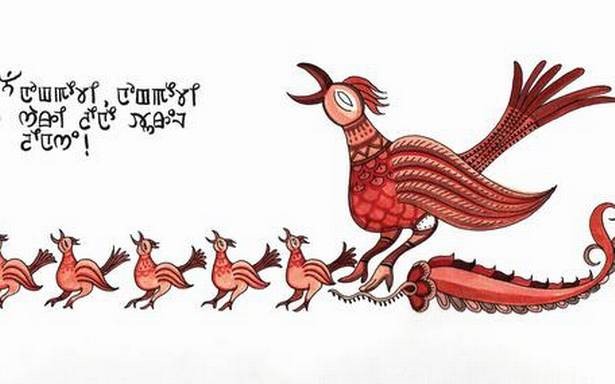Title: AND THAT IS WHY Manipuri Myths Retold
Date of publication: 21st June 2021
Author: L. Somi Roy
Published by: Penguin Random House India under the Puffin imprint
Illustrated by: Sapha Yumnam

‘And That is Why: Manipuri Myths Retold’ is a 93-page children’s book which consists of 12 incredible stories retold from the original Manipuri mythologies by L. Somi Roy. The book is published by Penguin Random House India under the Puffin imprint and was released on 21st June 2021. Somi Roy is also a cultural conservationist and a museum curator who writes on film, culture and polo for publications in India and the United States. He is also known for translating the book The Princess and the Political Agent written by M.K Binodini of Manipur. The illustrations in this book are made by Manipuri artist Sapha Yumnam who is currently teaching Art at Manipur University.
Many in Manipur would have heard of folk tales such as ‘Khamba-Thoibi’, the Manipuri equivalent of Shakespeare’s star crossed lovers which are quite popular but the tales that are told in this book And That is Why Manipuri Myths Retold are ancient and mostly retold by Manipuri balladeers and that is why I am sure most of the people from my generation or younger in Manipur would not have heard of such fantastic tales retold in a modern way. Somi Roy’s contribution is therefore immense. His is a collection of translated works from the original myths of ancient Manipur, rarely retold in the modern way before.
I have for instance never heard of any of the 12 tales in the book before this book came out. Somi Roy said in one of his interviews that these are only a few of the tales he chose to retell in this book because it is a children’s book and also because he personally liked the stories because of their inclusive nature, bringing in animals, birds and humans on the stage. There are magical, mythical creatures, gods and goddesses, birds, rituals, maibis — a great Manipur mythical world of its own. It is unimaginable how many such interesting tales must be embedded in our ancestral manuscripts! This book in its own way brings back to life the ‘puya’ or ancient Manipuri manuscripts. It is apparent that much hard work, in research, cross-checks and artwork, has gone into its making of this book thus the narrative flows easily for the reader.
The respected late scholar Ningthoukhongjam Khelchandra was the one who introduced the author to the ancient manuscripts. Valuable inputs also came from Thokchom Thouyangba Meitei who is also a scholar of ancient manuscripts, the artist Sapha Yumnam, and Manipuri historian Wangam Somorjit. Yoeman work also came from the publishers and many others involved in this book project.
This book not only revisits the treasure troves of the ancient mythological tales of the Meiteis, but it also is beautifully embellished by exquisite art works. The Greeks have their own myths, and then there is epic tales such as the Mahabharat and the Ramayana. These tales are widely known throughout the world because of their continuous retelling over and over again, in a thousand different ways. They are even studied as part of curriculum under literary studies. This book is an attempt at a makeover of Manipuri myths, so as to showcase them before all the people of the world.
Stories are what keep the dead alive right? This book, in my opinion, is a huge milestone in the world of Manipuri based literature. It is an important part of our heritage as a free people who can trace back their culture and social identity through these myths. They are myths; nonetheless, they have been passed down from our ancestors.
The first tale told in this book tells of how according to Manipuri mythology, woman was created before man on Earth. This is quite intriguing but this is how our ancestors saw creation and tried to make sense of it. The second story reveals how, according to another myth, our life spans as humans were a hundred years. It is quite an amusing chapter. Most of the tales from this book are amusing which makes it a great children’s book.
The third story is about the daughter of the Sky God, Soraren , Phou Oibi. The fourth story is another amusing tale of a cat and a tiger where the cat is the tiger’s aunt! The fifth story is a tale of kindness. The sixth is an extraordinary story of how Khurkhul silk made an imprint on Manipur from Burma. The seventh story is a tale from an anient Manipuri manuscript called ‘Khonggul Lirakpa’. The eighth tale is of community inclusiveness and also of a stubborn foreign pied cuckoo from Africa. The ninth tale is the story of Samadon, a Manipuri mythical creature. The tenth tale is a heart-wrenching tale of a little Kabui girl and her beloved doll. The eleventh story tells of Manipur’s connection with foreign places such as ‘the Great Shan Kingdom’. The final tale is about the birth of polo in the land? All the twelve tales are as varied as the 12 months of a year and each so unique and beautifully told, addressing young and older readers in a graceful tone.
As Somi Roy confirmed in one of his interviews, these are tales from a pre-Hindu Manipur and as the artist Sapha Yumnam also confirms the artwork found in the ancient manuscripts are “primitive” and they have a lot of warm toned colors such as red, brown, a little bit of black and grey and a lot less usage of blue. He has also use these colours to be as faithfully close to the originals that he replicated from for in this book, paying homage to an ancient artistic tradition. If he has added his own style, he took pains to make sure the new compliments the old seamlessly. This book, in my opinion again, is an eden of both art lovers and literature lovers. Thus, kudos to writer L.Somi Roy and artist Sapha Yumnam.

The writer is currently pursuing Masters in English Language and Literature from Manipal Academy of Higher Education, Bengaluru. She earlier interned at Bowel Cancer UK as a public relations assistant in London, and after receiving training as an English teacher under Via Lingua International in Istanbul











